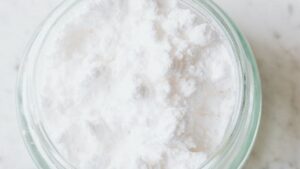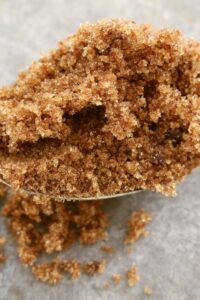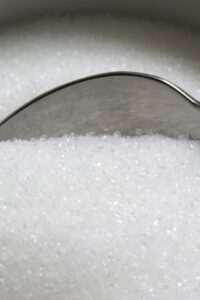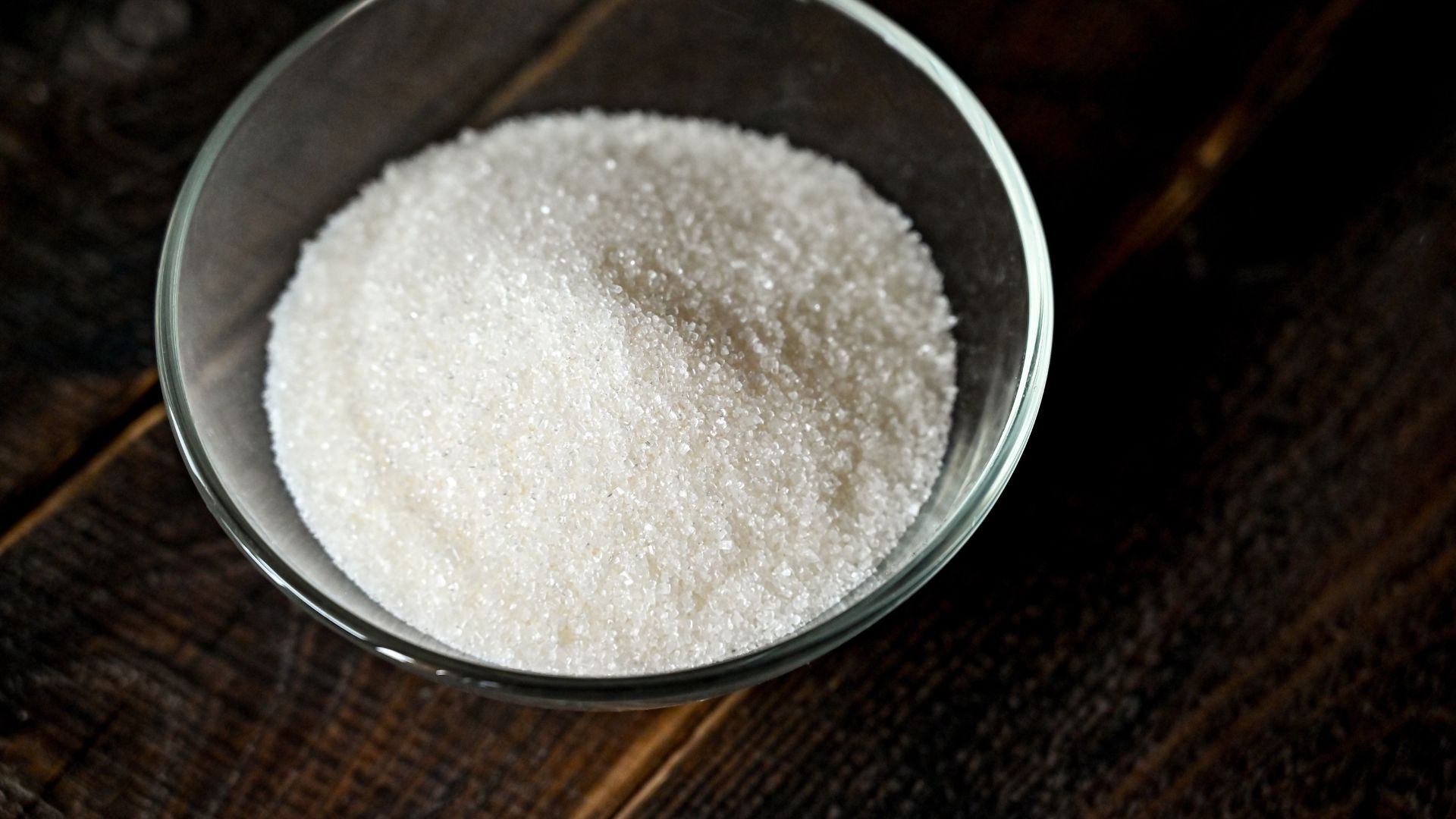When it comes to baking, sugar does much more than just make things sweet. Different types of sugar can completely change the texture, spread, and overall result of your cookies. In this topic, I’m going to talk about the different types of sugar used in cookie-making and what I’ve learned through my own personal experience with baking.
Table of Contents
ToggleWhat Is Sugar Type in Baking (ST)?
Sugar isn’t just about sweetness; it’s a vital ingredient that impacts how your cookies come out. There are many different types of sugar, each with its unique properties. Whether you’re using white sugar, brown sugar, superfine, or even powdered sugar, the type of sugar can dictate everything from how soft or crunchy your cookie is to how much it spreads on the baking sheet.== >> Check out the right cookie Sugar Type, tools, and ingredients that you need here.

Common Sugar Types Used in Cookies
1. Granulated Sugar
Granulated sugar is the most commonly used type of sugar in cookie recipes. It’s the white, crystalline sugar you’re probably used to seeing. When used in cookie recipes, granulated sugar is key to achieving a crispier texture and a lighter color. It also affects how much your cookie spreads as it melts during baking, creating those thin, crunchy edges people love.== >> Check out the right cookie Sugar Type, tools, and ingredients that you need here.
2. Brown Sugar
Brown sugar, which contains molasses, adds both sweetness and moisture. This results in chewier cookies with a richer, more caramel-like flavor. Dark brown sugar has more molasses than light brown sugar, so the flavor and texture are more pronounced with dark brown sugar.== >> Check out the right cookie Sugar Type, tools, and ingredients that you need here.

3. Superfine Sugar (Caster Sugar)
Superfine sugar, also known as caster sugar, has smaller granules than regular granulated sugar. Because of its fine texture, it dissolves more quickly and evenly. In cookie-making, superfine sugar helps create a smoother dough, resulting in cookies that have a finer crumb and a more even spread.== >> Check out the right cookie Sugar Type, tools, and ingredients that you need here.
4. Powdered Sugar
Also known as confectioners’ sugar, powdered sugar is extremely fine and often used in frostings and glazes. In some cookie recipes, powdered sugar can be used to create a delicate, melt-in-your-mouth texture, like in shortbread or tea cookies. Its fine consistency also helps absorb moisture, making your cookies softer and more tender.== >> Check out the right cookie Sugar Type, tools, and ingredients that you need here.
Why the Type of Sugar Matters
Each type of sugar has its own set of characteristics that impact your final cookie. For example, granulated sugar causes the dough to spread out, while brown sugar helps retain moisture, making for a chewier cookie. Superfine sugar, with its finer granules, leads to a smoother, more delicate dough, while powdered sugar can provide a soft, almost crumbly texture.
The type of sugar also affects the taste. Brown sugar will add a deeper, almost toffee-like flavor, while granulated sugar leaves a cleaner, less complex sweetness. Understanding how these sugars work can help you tweak your cookie recipes to achieve your perfect texture and flavor.== >> Check out the right cookie Sugar Type, tools, and ingredients that you need here.
So.
The sugar you choose is just as important as the flour or butter in your cookies. By experimenting with granulated, brown, superfine, or powdered sugar, you can control the spread, texture, and flavor of your cookies. In my own personal experience, changing the type of sugar in a recipe can give a completely different result, so it’s worth trying out different options to see which works best for your taste.== >> Check out the right cookie Sugar Type, tools, and ingredients that you need here.

Examples of How Different Sugars Affect Cookies
To really understand how sugars change your cookies, let’s dive into a few specific examples of how using different types can lead to varied results.
Example 1: Granulated Sugar vs. Brown Sugar
Take the classic chocolate chip cookie recipe. If you only use granulated sugar, the cookies will spread more during baking, creating thinner, crispier edges with a more delicate crunch. They’ll also have a lighter color and a slightly less complex flavor, leaning more on sweetness than depth.
On the other hand, if you swap out the granulated sugar for brown sugar, the cookies will be chewier and darker in color due to the molasses content in the brown sugar. The added moisture keeps the inside soft, while the flavor deepens into a more caramel-like richness. Most chocolate chip cookie recipes use a combination of both sugars to balance crispy edges with a chewy center.== >> Check out the right cookie Sugar Type, tools, and ingredients that you need here.
Example 2: Superfine Sugar in Sugar Cookies
Now let’s look at sugar cookies. These cookies are known for their smooth texture and precise shapes, often cut into festive forms for holidays. Using superfine sugar instead of regular granulated sugar helps achieve that perfect smoothness. The smaller granules dissolve quickly in the dough, which helps prevent grittiness and leads to a more uniform crumb. Your dough will also be easier to work with, making it ideal for rolling and cutting into shapes.
With granulated sugar, however, the dough may be a bit rougher, which could cause the cookies to spread more during baking, making it harder to maintain those clean, crisp edges.== >> Check out the right cookie Sugar Type, tools, and ingredients that you need here.
Example 3: Powdered Sugar in Shortbread Cookies
Shortbread cookies, which are known for their delicate, crumbly texture, benefit from the use of powdered sugar. The fine consistency of powdered sugar allows it to blend seamlessly with the butter and flour, creating a melt-in-your-mouth experience. These cookies don’t rely on much moisture, so the powdered sugar works to keep them light and soft without spreading too much.
If you were to use granulated sugar in shortbread instead, the larger crystals wouldn’t dissolve as easily, leading to a grittier texture and a cookie that spreads more during baking. The texture would also be less tender and more crisp, changing the essence of shortbread.== >> Check out the right cookie Sugar Type, tools, and ingredients that you need here.
Example 4: Brown Sugar in Molasses Cookies
Molasses cookies are another prime example where brown sugar shines. These cookies already have molasses added as a key ingredient, but using brown sugar deepens that warm, spiced flavor even more. Brown sugar’s higher moisture content pairs perfectly with molasses, giving the cookie a rich, chewy texture that stays soft for days.
Using granulated sugar in a molasses cookie recipe would result in a lighter flavor and a drier texture. The cookies would also spread more and lack that signature chewiness that people love about molasses cookies.== >> Check out the right cookie Sugar Type, tools, and ingredients that you need here.
How to Experiment with Sugars in Your Baking
If you’re curious to see how different sugars affect your favorite cookie recipes, it’s easy to experiment. Start by adjusting the ratio of granulated to brown sugar in your go-to recipes. For a chewier cookie, try increasing the amount of brown sugar. For a crispier result, use more granulated sugar. You can also experiment with superfine sugar in recipes where you want a more delicate texture or powdered sugar when you’re aiming for a tender, crumbly finish.
Understanding how different sugars affect cookie-making can take your baking skills to the next level. Whether you’re after crispy edges, chewy centers, or something soft and delicate, the type of sugar you use plays a huge role. By tweaking the sugar in your recipes, you can customize your cookies exactly how you want them.== >> Check out the right cookie Sugar Type, tools, and ingredients that you need here.
Drilling Deeper: Comparing Sugar Types in Cookie Making
Now that you’ve seen some examples, let’s dig even deeper into how different sugars stack up against each other when making cookies. In this section, I’ll compare various sugars head-to-head to show exactly how they affect your cookies’ texture, taste, and overall outcome.
Granulated Sugar vs. Superfine Sugar
- Granulated Sugar: Known for its larger crystals, granulated sugar creates a crispier texture in cookies. As it melts during baking, it encourages spreading, resulting in thinner, crunchier cookies with well-defined edges. This sugar is a go-to for cookies where you want some bite and crunch.
- Superfine Sugar: The finer texture of superfine sugar makes it dissolve faster, leading to a smoother cookie dough. This results in a cookie with a finer crumb and less spread. If you want your cookies to have a more uniform texture and slightly less crunch, superfine sugar is the better option. It’s particularly useful in sugar cookies or shortbread where smoothness is key.
Conclusion: Use granulated sugar for crispiness and spread, while superfine sugar is your best bet for a more delicate texture.== >> Check out the right cookie Sugar Type, tools, and ingredients that you need here.
Brown Sugar vs. Granulated Sugar
- Brown Sugar: The molasses in brown sugar adds moisture, contributing to a chewier texture and a richer, more complex flavor. Dark brown sugar has an even more intense molasses flavor, which enhances warm spices or chocolate in cookies. Brown sugar also helps the cookies stay soft longer due to its hygroscopic (moisture-retaining) nature.
- Granulated Sugar: This sugar, on the other hand, creates a drier and crispier cookie. Since it doesn’t contain moisture-rich molasses, cookies made with granulated sugar tend to have a cleaner, more neutral sweetness. They’ll also spread more, resulting in a thinner cookie with a crunchier bite.
Conclusion: Brown sugar is perfect when you want chewy, moist cookies with a deep flavor. Granulated sugar, however, is better for a crisp texture and a simpler, cleaner sweetness.== >> Check out the right cookie Sugar Type, tools, and ingredients that you need here.
Brown Sugar vs. Powdered Sugar
- Brown Sugar: We know brown sugar helps create a chewy, moist texture in cookies due to its molasses content. This sugar works best in cookies where you want a heartier bite, such as chocolate chip, oatmeal, or molasses cookies. It lends a rich flavor that complements dark chocolate or spices.
- Powdered Sugar: Powdered sugar, in contrast, creates an entirely different result. Because it’s so fine, it blends seamlessly into the dough, resulting in a tender, crumbly cookie that almost melts in your mouth. This sugar doesn’t encourage much spread, making it ideal for cookies like shortbread or snowball cookies where you want a delicate, tender texture.
Conclusion: Use brown sugar when you want chewy, rich-flavored cookies, and powdered sugar when you’re aiming for delicate, tender, melt-in-your-mouth treats.== >> Check out the right cookie Sugar Type, tools, and ingredients that you need here.
White Sugar vs. Raw Sugar
- White Sugar (Granulated): As mentioned earlier, white sugar promotes spreading and creates crispy cookies. Its neutral sweetness works well in a wide range of recipes, offering a clean, predictable result.
- Raw Sugar (Turbinado or Demerara): Raw sugar has larger, coarser crystals and retains some of its natural molasses. This sugar gives cookies a crunchier texture due to its crystal size and adds a subtle caramel flavor. It doesn’t dissolve as easily as white sugar, so it’s often used as a topping for a crunchy finish rather than mixed into the dough.
Conclusion: Stick with white sugar for a classic, predictable cookie texture, but use raw sugar if you want extra crunch or a rustic, slightly caramelized finish.== >> Check out the right cookie Sugar Type, tools, and ingredients that you need here.
Brown Sugar (Light) vs. Brown Sugar (Dark)
- Light Brown Sugar: Light brown sugar contains less molasses than dark brown sugar, so it gives cookies a mild caramel flavor and a chewy texture. It’s versatile and works well in many recipes, from classic chocolate chip cookies to spice cookies.
- Dark Brown Sugar: With more molasses, dark brown sugar brings a deeper, more pronounced flavor to your cookies. It’s perfect when you want to intensify the flavor profile, especially in recipes like gingerbread or molasses cookies. It also enhances moisture retention, making cookies extra soft and chewy.
Conclusion: Light brown sugar offers subtle caramel sweetness and chew, while dark brown sugar provides more intensity in both flavor and texture. Use dark brown sugar for cookies that need a deeper, richer flavor.== >> Check out the right cookie Sugar Type, tools, and ingredients that you need here.
Granulated Sugar vs. Powdered Sugar
- Granulated Sugar: Granulated sugar is best for cookies where you want defined edges and a crisp finish. Its larger crystals melt and spread during baking, creating a thin and crispy texture, especially at the edges.
- Powdered Sugar: Powdered sugar, due to its fine texture, absorbs more moisture and results in a softer, crumbly cookie. Cookies made with powdered sugar are typically more tender and delicate, with little to no spread, perfect for shortbread or thumbprint cookies.
Conclusion: Granulated sugar delivers crisp, spread-out cookies, while powdered sugar gives you soft, melt-in-your-mouth delicacies.== >> Check out the right cookie Sugar Type, tools, and ingredients that you need here.
Which Sugar Should You Use for Specific Results?
- Chewy Cookies: Brown sugar is your best friend here. Its molasses content keeps the dough moist, creating that perfect chewy texture.
- Crispy Cookies: If you’re after crunch, granulated sugar is the way to go. It allows the cookie to spread more and crisp up as it bakes.
- Delicate, Tender Cookies: Superfine or powdered sugar will help you create a cookie that’s tender, soft, and crumbly, without much spread.
- Balanced Cookies: Many cookie recipes balance granulated and brown sugar to get the best of both worlds: crispy edges with a chewy center. Try adjusting the ratio to fine-tune the texture and sweetness to your liking.== >> Check out the right cookie Sugar Type, tools, and ingredients that you need here.
Comparison Tabular Sugar Types in Cookie Making: Key Notes and Considerations
| Sugar Type | Texture Impact | Flavor Impact | Key Uses | Considerations |
|---|---|---|---|---|
| Granulated Sugar | Crispy, spreads during baking | Clean, neutral sweetness | Chocolate chip, snickerdoodles | Causes cookies to spread; creates thin, crisp edges. Use for crunchy textures. |
| Brown Sugar | Chewy, retains moisture | Caramel, molasses flavor | Chocolate chip, oatmeal, spice | Adds moisture; best for chewy cookies. Dark brown sugar gives more intense flavor. |
| Superfine Sugar | Finer crumb, less spread | Slightly sweeter due to quick dissolve | Sugar cookies, meringues, sponge cakes | Dissolves faster, resulting in smoother dough. Great for even-textured cookies. |
| Powdered Sugar | Tender, crumbly, little spread | Subtle sweetness | Shortbread, snowball cookies | Fine texture creates a melt-in-your-mouth consistency. Absorbs moisture, creating softer cookies. |
| Raw Sugar (Turbinado/Demerara) | Crunchy due to large crystals | Mild caramel flavor | Topping for sugar cookies, scones | Best used as a topping for texture contrast. Doesn’t dissolve well in dough. |
| Light Brown Sugar | Chewy, slightly moist | Mild caramel flavor | Chocolate chip, spice cookies | Adds subtle flavor and moisture; good balance between chewiness and flavor depth. |
| Dark Brown Sugar | Extra chewy, very moist | Rich, deep molasses flavor | Gingerbread, molasses cookies | Best for cookies needing a robust flavor; adds intense sweetness and moisture. |
| White Sugar vs. Brown Sugar | White = Crispy, Brown = Chewy | White = Clean sweetness, Brown = Caramel-like | Best for balancing chewiness (brown) and crispness (white) in cookies | Adjust ratio for desired texture. Combining both often gives the perfect balance of crispy and chewy. |
Key Notes:
- Texture: Granulated sugar leads to more spread and crispiness, while brown sugar and powdered sugar retain moisture, creating chewiness or softness.
- Flavor: Brown sugar offers a richer, more complex flavor due to molasses, while granulated and powdered sugars provide a simpler, neutral sweetness.
Considerations:
- Adjusting Ratios: You can modify the texture and flavor of your cookies by changing the ratio of granulated to brown sugar.
- Desired Texture: Use superfine or powdered sugar for smooth, tender cookies; opt for brown sugar for chewy cookies.
- Spread Control: Granulated sugar increases spread, while superfine and powdered sugars reduce it, resulting in thicker cookies.
FAQs on Sugar Types in Cookie Making
1. What’s the difference between granulated and superfine sugar in cookies?
Granulated sugar has larger crystals that create a crispier texture and allow cookies to spread more during baking. Superfine sugar, with its smaller crystals, dissolves faster, resulting in a smoother dough and less spread, producing a more uniform, delicate cookie.
2. Can I substitute brown sugar for white sugar in cookie recipes?
Yes, but it will change the texture and flavor. Brown sugar adds moisture, making cookies chewier, while white sugar leads to crispier cookies. Brown sugar also imparts a caramel-like flavor due to the molasses content.
3. Why use powdered sugar in cookies?
Powdered sugar is often used in cookies for a softer, melt-in-your-mouth texture. Its fine consistency absorbs moisture, making cookies tender and crumbly, which is why it’s commonly found in recipes for shortbread or tea cookies.
4. How does raw sugar affect cookies?
Raw sugar has larger, coarser crystals that don’t dissolve easily, so it’s often used as a topping for added crunch rather than mixed into the dough. It can give cookies a mild caramel flavor but isn’t ideal for smooth dough consistency.
5. Why do cookies spread more when I use granulated sugar?
Granulated sugar melts during baking, causing cookies to spread more. The larger crystals take longer to dissolve, which increases the spread and results in a thinner, crispier cookie.
6. Can I mix different types of sugar in my cookies?
Yes! In fact, many cookie recipes mix granulated and brown sugar to balance the texture—crispy edges from granulated sugar and chewy centers from brown sugar. Experimenting with sugar ratios can help you find your ideal cookie texture.
7. What’s the impact of using dark brown sugar instead of light brown sugar?
Dark brown sugar contains more molasses than light brown sugar, resulting in a richer, more intense flavor and extra moisture. This makes cookies even chewier with a deeper caramel taste, perfect for recipes that benefit from strong flavors, like molasses or gingerbread cookies.== >> Check out the right cookie Sugar Type, tools, and ingredients that you need here.
Final Words on Sugar Types in Cookie Making
Mastering cookie-making involves more than just following a recipe; understanding the role of sugar is key to perfecting your results. Whether you’re aiming for crispy, chewy, or tender cookies, the type of sugar you choose dramatically impacts the outcome.
From the moisture-retaining properties of brown sugar to the fine texture of powdered sugar, each type offers a different experience. Experiment with different combinations, adjust your ratios, and see how small changes can make a big difference in your cookies’ texture and flavor.
Related Posts
- BSP: Brown Sugar Powder role in cookie making Explained
When it comes to baking, especially cookies, you’ll often come…
- MPS: Malted Powdered Sugar role in cookie making Explained
In this topic, I'm going to talk about Malted Powdered…
- HSP: Honey Sugar Powder role in cookie making Explained
In this topic, I’m going to talk about Honey Sugar…
- Why do my sugar cookies taste awful
Are your sugar cookies turning out less than perfect? Don't…
- TR: Truvia (Stevia) role in cookie making Explained
When it comes to baking, especially cookies, finding the right…
- T: Turmeric role in cookie making Explained
In this topic, I'm going to talk about something close…
- KT: Kiwi Tart role in cookie making Explained
In this topic, I'm going to talk about Kiwi Tart,…
- YE: Yeast Extract role in cookie making Explained
In this topic, I’m going to talk about yeast extract…
- RS: Raisin Syrup role in cookie making Explained
In this blog, I'm talking about Raisin Syrup (RS) and…
- GI: Ginger role in cookie making Explained
In this blog post, I’m going to talk about ginger,…
- RD: Raisins role in cookie making Explained
When it comes to baking cookies, raisins might not always…
- MR: Maple Rum role in cookie making Explained
In this topic, I’m going to talk about MR –…
- GB: Gluten-Free Blend role in cookie making Explained
In this blog, I’ll talk about my journey with gluten-free…
- XG: Xanthan Gum role in cookie making Explained
In this blog, I’m going to talk about xanthan gum…
- PC: Peanut Chips role in cookie making Explained
In this topic, I’m going to talk about peanut chips,…

